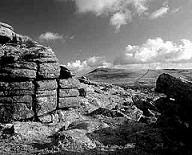Textile designer Jane Deane has a ready supply of silk to create her work – she raises her own colony of moths in the bath at her Devon home!
Jane from Tavistock uses the tub to house a number of different varieties of moth including the Bombyx Mori, which is recognised as producing the best quality silk - but she also has a variety of wild silkmoths that she uses in her creative work.
All the moths are allowed to complete their short life cycle and it is the discarded cocoons, from where the silkworm caterpillars emerge as moths, that Jane uses to make a variety of textile products.
Jane’s passion for silk moths began when she had the opportunity to attend a 10 day course with leading artist weaver Sue Hiley-Harris.
“Moths are quite extraordinary creatures and I became fascinated with the way they begin life in an egg the size of a pinhead, emerge as a caterpillar and then spin a cocoon in which to metamorphasise into a moth, “ said Jane, a resident artist at Duchy Square Centre for Creativity in Princetown.
“It is such a short life as they immediately mate and lay eggs for the next generation before dying. It is a quite magical process though and even after all these years of keeping silkworms I still find witnessing their life cycle as awe inspiring as when I first saw it.”
By spinning the silk instead of reeling it, Jane can ensure her moths are able to live out their natural lifespan. Reeling the silk would involve using the cocoon before the moth had emerged as it requires the single thread from the cocoon to be unwound intact.
To spin the silk, Jane removes the protective gum the caterpillar excretes to harden it by boiling it in soap flakes with a little washing soda. She then stretches the softened cocoon over a plastic pudding basin and allows it to dry before dyeing it and then spinning a thread.
Alongside her own products, which she creates using natural and synthetic dyes, Janes offers talks on the silk moth processes and workshops in spinning, weaving and dyeing. Although these are her main disciplines, she also does paper-making, batik, embroidery, knitting and braiding.
She was recently invited to join the Society of Dyers and Colourists and is also a member of Frayed Edges Weaving Group, formed in 2004 for the graduates of Bradford College of Art and Design, which exhibits nationally.
Opened in March and supported by a number of organisations, including The Duchy of Cornwall and Devon County Council, the Duchy Square Centre for Creativity offers low cost workshop space on two floors and is helping boost the local economy by connecting local businesses with other key industry sectors.
The artists and creative practitioners take part in workshops organised by the centre, but also stage their own sessions with smaller groups in their own studios. Anyone wishing to find out more about all the workshops on offer should telephone the centre on (01822) 890828 or
visit the website www.duchysquare.org where contact details for all the artists can be found.
 w to paint great landscapes, then you should spend time near the area that inspires you to paint in the first place. Only then can you really understand how to transfer what it is you see to canvas.
w to paint great landscapes, then you should spend time near the area that inspires you to paint in the first place. Only then can you really understand how to transfer what it is you see to canvas.


